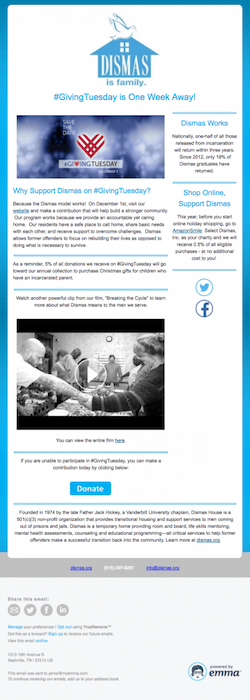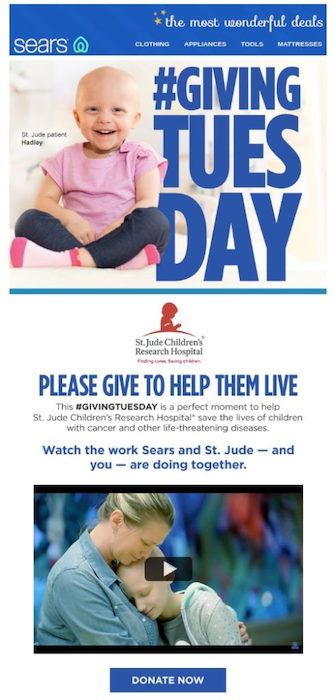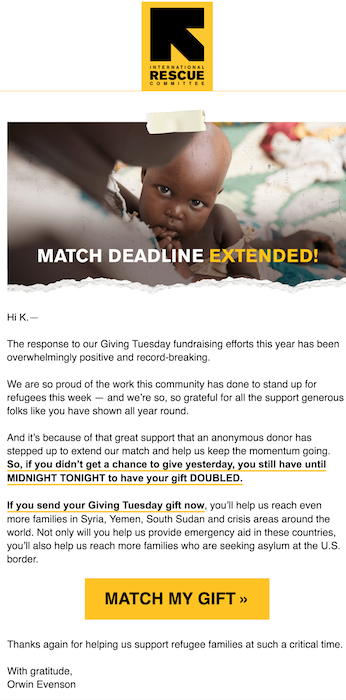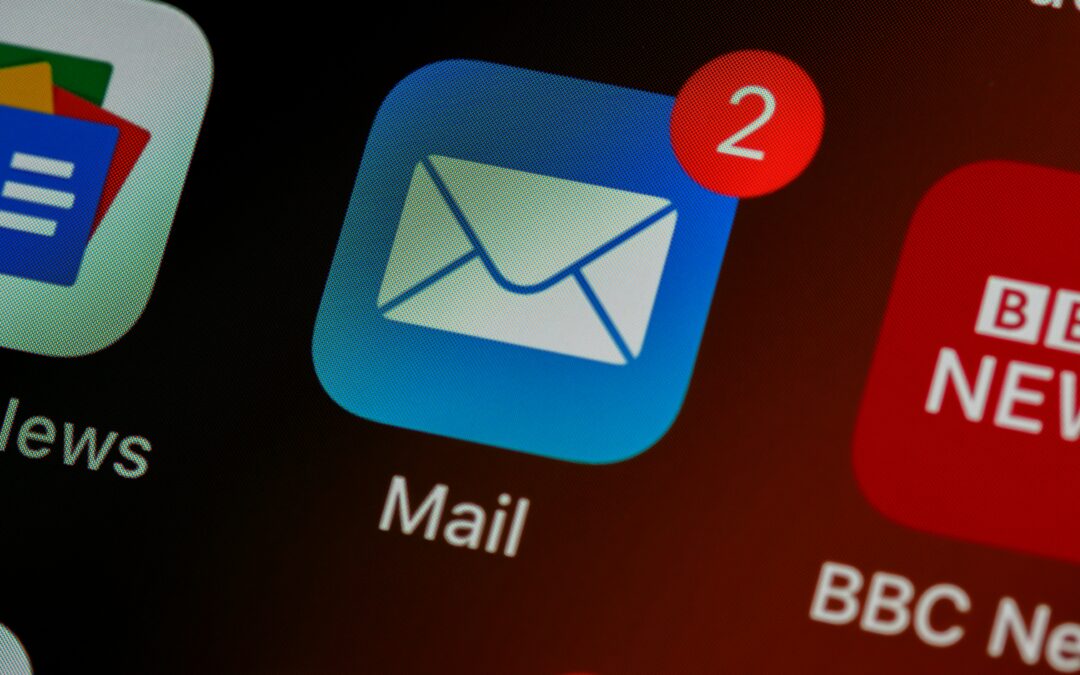Emails drive 13% of all online nonprofit revenue. While it may seem like a small share, it does make a significant difference when that revenue is in the hundreds of millions of dollars.
Giving Tuesday is one of the most valuable campaigns for nonprofit fundraising. In 2019, Giving Tuesday brought in over $511 million through online donations, a significant chunk of that being from emails.
Needless to say, you need to craft compelling emails to achieve your fundraising goals. In this post, we’ll go over 6 Giving Tuesday email examples to inspire you to create emails that people can’t help but click (and donate).
Giving Tuesday email campaign timeline
Before you start creating your emails, it’s good to know the kind of emails and content you need. Understanding the campaign timeline can help you with that.
For emails, the following days will be the most crucial:
- One week before Giving Tuesday (23rd-25th Nov) – This is when you’ll announce the campaign and start building anticipation.
- Thanksgiving (26th Nov) – On this day, you’ll engage people with holiday wishes and give them a subtle reminder of the upcoming giving day.
- One day before Giving Tuesday (30th Nov) – This is the day when you’ll send a final reminder about Giving Tuesday coming up.
- Giving Tuesday (1st Dec) – On this day, you’ll be sending prospects fundraising emails encouraging them to donate. While you can include donation appeals in previous emails, these emails will be highly focused on appeals rather than nurturing.
- Days after Giving Tuesday (2nd-3rd Dec) – After Giving Tuesday, you’ll be sending everyone appreciation emails (whether they donated or not) and showcase what you achieved on Giving Tuesday.
Based on this flow, here are the emails that you will need to prepare to nurture prospects and convert them to donors.

You can use this flow as a guide for the main focus of each of your emails. With the focus in mind, designing and creating content for Giving Tuesday emails becomes a tad easier.
Giving Tuesday email examples
Let’s take a look at a few Giving Tuesday email examples from successful campaigns to inspire your emails.
1. Announcement emails
The announcement email serves as a heads up for your existing donors and prospective ones that you need their support.
This is also a good opportunity to inform people about Giving Tuesday. A study showed that only 18% of people are aware of Giving Tuesday and its significance. Informing them about it is a good way to grab their interest.
Here’s an example of an announcement email from Charity: Water:

Source: Campaign Monitor
Takeaways from the email
- Visual appeal: The email doesn’t just use a standard header image to grab your attention; it leverages visuals to keep you hooked and convey important information throughout the email.
- Statistics: While visuals are needed to grab attention, numbers are what convince people. The email uses statistics to showcase how others have helped them reach closer to the goal. This adds to the social pressure and convinces readers to get on board too.
2. Informational emails
While the Giving Tuesday announcement email may cover some information about the campaign, prospects will need a little more convincing before they convert.
After the announcement, you can follow up with an informational email explaining:
- Why they should donate
- What you are trying to achieve
- How it works/how to be a part of the campaign
Here’s a perfect example of an informational Giving Tuesday email from Dismas Charities.

Source: Kindful
Takeaways from the email
- Calls-to-action: If you go through the email, you’ll notice that they don’t use a prominent call-to-action. The buttons are visible but are subtle. This ensures that the focus of the informational email is not conversion but conveying information. The email gets people interested in the campaign and avoids coming off as pushy, reaching out only to raise funds, which could put off prospects.
- Social sharing icons: The ladder of engagement concept states that to get people to take a more prominent action, start by making smaller asks. The social icons serve that purpose. By getting people to share the email on social media or following your handles, you get them to take small steps before asking them to go over a bigger barrier (donating).
3. Beneficiary stories
In her study on fundraising, Deborah Small concluded that people are more likely to give if you appeal to their emotions with a story. Showcasing a story with a single relatable beneficiary works best.
In collaboration with Sears, St. Jude’s Children’s Hospital implements this well in their Giving Tuesday email.

Source: Sendinblue
Takeaways from the email
- Video: Not a lot of people are going to read through your entire email. That poses the risk of people not connecting with the story as well. Since a video is more engaging than big blocks of texts, adding the story as a video is a great way to avoid people skipping it. Note that the email doesn’t have much text and tries to get the reader’s attention to the video quite immediately.
- Corporate partnerships: If you notice, the email is sent by Sears (and not the nonprofit) showcasing their corporate partnership. This is a good strategy for nonprofits that are relatively new and lesser-known among the masses. Partnering with a business can get you access to the businesses’ contacts, and hence a larger audience.
To know more about creating the perfect story for your emails, check out this article.
→ The perfect nonprofit storytelling approach to create effective messaging
4. Giving Tuesday reminder email
A week before Giving Tuesday, Thanksgiving, Cyber Monday, and Black Friday marketing texts and emails may distract prospects. Therefore, it’s a good idea to send them a brief reminder about the campaign a day before.
Make sure to remind them why it’s important to give and how to give, so they’re prepared at the right moment. Here’s an example of Coral Acres sending a simple Giving Tuesday reminder email.

Source: DonorPerfect
Takeaways from the email
- Email copy: Notice how concise the email is. That’s how a good reminder should be. You don’t need a long copy explaining everything since you’ve covered that in previous emails. Just a brief highlight with a call to action works best.
- Peer-to-peer fundraising: People are more likely to give to someone they know rather than an organization, which is why P2P fundraisers are so effective. Giving them a chance to set up a fundraiser is a great way to get donors more closely involved with the campaign and get more funds out of them.
5. Solicitation email
Finally, on Giving Tuesday, your focus is now on getting people to convert. A few elements that can give people the final push and inspire them to donate include:
- Inducing a sense of urgency
- Leveraging beneficiary stories
- A result-oriented approach
- Leveraging social pressure to get people to give
Here’s a Giving Tuesday email example from the International Rescue Committee.

Takeaways from the email
- Leverages social pressure: At the start of the email, the organization points out how others like the receiver have shown their generosity. The social influence, coupled with the sense of urgency (to act before midnight), gives prospects the extra push to donate.
- Result-oriented appeal: The email ends with an appeal that clearly states how the prospect’s donation will be used. This highlights the importance of the donation, which in turn encourages people to act.
6. Thank you email
Thanking donors is the most important part of your campaign. Appreciating their support and making them feel valued is the first step to donor retention. You don’t want them thinking that you don’t have any need for them after their donation, because clearly, you do!
A good thank you email is one that is:
- Simple but personalized
- Talks about the impact the donor made (or will be able to make)
Here’s a great Giving Tuesday thank-you email example from Bestwa

Takeaways from the email
- Personalized thank-you: Addressing the receiver by name, a personal note, and the signature of the organization’s director is what makes this email great. These small elements make the email extremely personalized and, therefore, more impactful in making the recipient feel appreciated.
- Highlight the impact: The email also talks about the exact amount raised and the number of people benefiting from it. Talking about the impact reinforces the importance of giving. Reminding people about that sets the foundation for future nurturing and repeat giving.
While these examples cover most tips and best practices, there are a few more aspects that you must take care of to create impactful Giving Tuesday emails.
Read Next: Done With Giving Tuesday? Here Are Some Of The Best Ways To Thank Your Donors.
Giving Tuesday Email Best Practices
1. Giving Tuesday email subject lines
Your subject line is the first thing that your prospects see. Your efforts to create the perfect email won’t pay off if the subject line doesn’t compel them to open it.
The perfect email subject line for Giving Tuesday campaigns is one that:
- Is concise. A study showed that shorter subject lines had higher open rates.
- Forces them to think. Typically questions work best for this.
- Induces urgency. Adding a time factor has also proven to work well for subject lines.
2. Best time to send Giving Tuesday emails
A study by NextAfter Institute showed that the peak time for sending emails was between 7 am and 1 pm.
Since most organizations might use this as a reference and send emails during these hours, sending it during this period could lead to your email getting lost in the crowd.
Instead, you could plan to send emails when the competition for the inbox is lower.
- Between 5-6 pm. During this time, people may be on their way home and hence would have the time to go through your email.
- Between 1-3 pm. When people are not focused on work during lunch hours, it is also a good time to get their attention.
You May Also Like: 30+ Fundraising Giving Tuesday Script Samples to Ease Your Job
3. How many emails to send on Giving Tuesday
A survey by MR Benchmarks showed that multiple fundraising emails tend to outperform single emails in terms of responses and average gift size. Typically, a 2-3 email series could quadruple the response rates.
On Giving Tuesday, you could plan for an email series that would include:
- A kick-off email that marks the beginning of the campaign with a donation appeal.
- Campaign update email highlighting how much was raised or how many people donated to leverage social pressure.
- A campaign ending email inducing a sense of urgency to motivate people to act.
Keep in mind that there is no single solution for all these best practices that will work best. Therefore, make sure to A/B test your emails to find out what works best.
For more insights on email marketing best practices, check out this article:
→ Email marketing for nonprofits: Best practices and tools
To conclude
Hopefully, these Giving Tuesday email examples have given you some ideas for your campaign. Use these insights and get started on creating the perfect emails for fundraising.
However, keep in mind that while email does account for a significant share of online fundraising, it’s not the only channel that you should rely on. Along with email, social media is also something that you must leverage. Check out these social media fundraising strategies that you could also benefit from.
Featured image source: Brett Jordan


